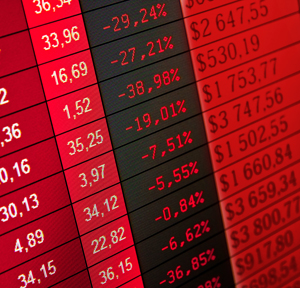Investment Strategies
Global Equities Catch Winter Cold

Equity benchmarks in Asia, Europe and the US fell yesterday, prompting thoughts that after almost a decade of ascent, the bull market for stocks has hit the buffers.
(Updated with new price action, commentary)
Equities extended their slide from Monday today. The Nikkei 225 benchmark of Japanese equities, for example, was down more than 4.7 per cent as of 7:15 GMT today, while other equity markets were off or priced for further decline. Yesterday, the the US Dow Jones Industrial average recording its largest-ever point drop and indices in Asia and Europe slipping, prompting thoughts that the much-touted inflection point in markets had been reached at last.
The Dow closed down 1,175 points yesterday, off 4.6 per cent; the S&P 500 was down 4.1 per cent; the Nasdaq Composite Index was down 3.78 per cent (source: Bloomberg, WSJ, other). European and Asian bourses fell.
Hong Kong’s Hang Seng Index dropped 1.09 per cent on Monday, and lost 4.13 per cent today, while Singapore’s main benchmark of stocks fell 1.47 per cent on Monday, and was off 2.24 per cent in late trade today (source: Bloomberg).
DBS, the Singapore-headquartered banking group, cautioned against panic. "This does not herald the start of a bear market. Yes, bond yields have been rising due to falling unemployment and rising wages. And yes, the recent rebound in energy prices has also added fuel to the rising rates argument. But to argue that a secular bear market for bonds (and by extension, equities) is in place would be a bit of a stretch," it said in a note.
"Taken together, the US market has lost 6.1 per cent since Friday while the Euro Stoxx 50, Nikkei 225 Index, and MSCI Asia ex-Japan Index have also registered average declines of 2.9 per cent. To recap, the consolidation came as US nonfarm payrolls data was better than expected – at 200,000 in January (vs. the consensus forecast of 180,000). More importantly, average hourly earnings gains of 2.9 per cent y/y was the highest since 2009. Not surprisingly, the knee-jerk reaction was on fears that inflation is back, thus necessitating the US Federal Reserve to raise rates faster than their earlier guidance," the bank said.
There have been rumblings of concern for months that stocks, such as those in the US, were expensive on a cyclically-adjusted basis and that investors should diversify; the rally in equities since 2009, fuelled to some extent by central bank quantitative easing, was arguably due for a correction. US equities began this year on an upward path amid investor cheer about the US corporate tax cuts and hopes for an inflow of US business earnings back to the US.
A week ago, the Dow, S&P 500 and Nasdaq Composite surged to all-time highs. The latest twist means the Dow is now about 1.5 per cent below where it started this year.
Recent market strength, coupled with falls in unemployment, had prompted thoughts that the US Federal Reserve would continue on its path of gradually moving official borrowing costs back towards more “normal” levels after the era of ultra-low, or even negative, rates.
The wealth management arm of UBS struck a sanguine note. Its chief investment officer said: "While volatility may persist in the very near term, we remain confident that the bull market remains intact. We may have moved from being `overdue' for a pullback, to approaching `overdone,' with this latest technical-driven sell-off."
"Unlike last Friday's 2.1 per cent sell-off, which was likely sparked by inflationary fears when US average hourly earnings jumped to a post-crisis high of 2.9 per cent, there were no obvious economic triggers to today's market decline. Technical factors likely played the lead role in the continuation of selling pressure and the speed of the late-day decline. Both the deleveraging of select institutional buyers with portfolio risk limits, and the market breaching its 50-day moving average, likely accelerated the intra-day drop," UBS added.
“Events of the past couple of decades have led investors to
expect markets to rebound quickly from a major correction.
Seemingly forgotten is the worst sell-off of the US stock market,
which began in 1929 and resulted in a decline of almost 90 per
cent. It took 23 years to recover. For those tempted to dismiss
this as outdated data, take note that the Nikkei index hit an
all-time high of approximately 39,000 in 1989. 28 years later it
is still approximately 40 per cent below its all-time peak,”
Donald A. Steinbrugge, chief executive of Agecroft Partners, a
hedge fund consulting and marketing firm, said.
“Instead of trying to time the market, investors should construct
a diversified portfolio that can withstand market turbulence
thereby avoiding the need to sell at market bottoms.
Unfortunately most investors significantly underestimate the
`tail risk’ of their portfolios, he said.
